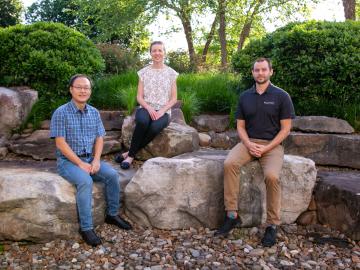Filter News
Area of Research
- (-) Biology and Environment (16)
- Advanced Manufacturing (1)
- Building Technologies (2)
- Clean Energy (18)
- Computational Biology (1)
- Computer Science (1)
- Electricity and Smart Grid (1)
- Functional Materials for Energy (2)
- Fusion and Fission (6)
- Isotopes (3)
- Materials (23)
- Materials for Computing (2)
- National Security (4)
- Neutron Science (5)
- Renewable Energy (1)
- Supercomputing (7)
News Type
News Topics
- 3-D Printing/Advanced Manufacturing (2)
- Advanced Reactors (1)
- Artificial Intelligence (2)
- Bioenergy (4)
- Biology (7)
- Chemical Sciences (2)
- Clean Water (1)
- Climate Change (2)
- Composites (1)
- Computer Science (1)
- Critical Materials (1)
- Cybersecurity (1)
- Energy Storage (2)
- Environment (5)
- Grid (1)
- High-Performance Computing (2)
- Hydropower (2)
- Machine Learning (1)
- Materials (2)
- Materials Science (1)
- Microscopy (1)
- Nanotechnology (1)
- Neutron Science (1)
- Nuclear Energy (1)
- Partnerships (1)
- Sustainable Energy (2)
- Transformational Challenge Reactor (1)
- Transportation (1)
Media Contacts

Seven scientists at the Department of Energy’s Oak Ridge National Laboratory have been named Battelle Distinguished Inventors, in recognition of their obtaining 14 or more patents during their careers at the lab.

The presence of minerals called ash in plants makes little difference to the fitness of new naturally derived compound materials designed for additive manufacturing, an Oak Ridge National Laboratory-led team found.

Researchers at Oak Ridge National Laboratory have identified a key need for future hydropower innovations – full-scale testing – to better inform developers and operators before making major investments.

Eight ORNL scientists are among the world’s most highly cited researchers, according to a bibliometric analysis conducted by the scientific publication analytics firm Clarivate.

ORNL researchers discovered genetic mutations that underlie autism using a new approach that could lead to better diagnostics and drug therapies.
A team from Oak Ridge National Laboratory, Duke University and other institutions studying Sphagnum moss have identified two new species in North America, and they are learning how evolution may affect the species’ role in carbon storage.

Global carbon emissions from inland waters such as lakes, rivers, streams and ponds are being undercounted by about 13% and will likely continue to rise given climate events and land use changes, ORNL scientists found.

A team of scientists led by Oak Ridge National Laboratory developed a theory that thylakoids, membrane networks key to plant photosynthesis, also function as a defense mechanism to harsh growing conditions, which could aid the development of hardier plants.
Scientists at Oak Ridge National Laboratory are closer to unlocking the secrets to better soil carbon sequestration by studying the tiny, sand-like silicon deposits called phytoliths in plants.

The Department of Energy’s Office of Science has selected three Oak Ridge National Laboratory scientists for Early Career Research Program awards.




